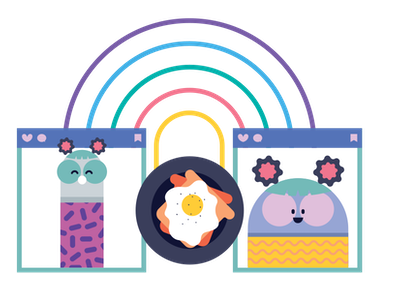- Website SEO Marketing
- Blog
- Website
- What is UI (User Interface) and UX (User Experience)?
What is UI (User Interface) and UX (User Experience)?

UI and UX are two inseparable concepts that often come across when technology is developing so much. Although UI (user interface: user interface) and UX (user experience: user experience) dec different meanings, they are examined from the same window because they have close relationships. Let's take a look at these concepts together…
What is UI?
The UI, which stands for user interface, refers to the user interface. We can also say that it is the unit that allows us to interact with the screens of phones, tablets or computers. The keys on our phones, all the technological areas that we enter by clicking, simply summarize the UI concept. The UI is not keys or clickable regions. In contrast, this is the design of the zones (UID: user interface designer). In short, the UI is everything that a person using a technological device can see or access, and this is the design of everything.
The design of UI helps to determine the value of technological applications. The value of a beautifully designed as well as UI-enhanced application will be higher. Because the studied UI attracts the attention of users and offers them a comfortable use. Although the UI is usually identified with the technology world, UI development is involved in almost every product. The goal here is to use the product in a fairly simple and practical way. Exactly at this point, the concepts of UI and UX can be confused. UX is a topic that summarizes the user experience and is related to the design of the product. The UI is the unit that deals more with the graphic design of the work. For example, the UI thinks about the color, shape, placement of keys.
The UI is a painstaking design of every detail. For this reason, it is a concept that is associated with graphic design. He is engaged in the design of all areas where the user interacts with any device. The keys with which the user will interact are interested in such concepts as the shape, size, color, spacing of these keys. In addition, interface design is the design of concepts such as key placement, layout, size, color as a whole. In a successful interface, all this seems to be in harmony. In this way, the product will be very user-friendly but very user-efficient.
Where Are the Areas of Use of UI Design?
It is possible to see UI design in every conceivable product. It is a UI design of keys, menus on devices such as phones, tablets, computers. In addition, features such as button locations, colors on devices such as washing machines and irons that we often use in everyday life are also a product of the UI design. We can say that the expectations of users from the UI design are that it offers practical use and is in a technically sufficient state.
What is UX?
UX, which stands for user experience, refers to the user experience. We can't understand how time passes when we spend time on some platforms from time to time, can we? The reason for this is exactly what this is. Although UX refers to the user experience, it also includes the feelings that users create on it. It is a design made in order for the products to be used and satisfied by the users more consciously. Especially on the 21st. it has been actively used in many products since the XVIII century. Increasing the user's time to use the product means widespread use of UX. UX desing has a great importance in the design industry because it is used in many products and because it is a concept that benefits.
Expressing the user experience, UX, contrary to popular belief, does not support people's dependence on the product. In contrast to this situation, it adopts the concept of “human first”. In this way, it helps to increase the usability and practicality of products by offering designs in a way that is for the benefit of people. Consumers have an experience with each product they use. Especially since the source of these experiences is a vast world such as the internet, UX has had a great importance in the design world. Consumers use various mobile applications or Internet sites for ordering food or online shopping. At this point, the consumer may have various emotions on his mind when browsing the site or application: boring, of good quality, uninteresting, unnecessary. In order for such feelings to shift to a more positive side, UX is of great importance.
This concept, which we know as the user experience, was introduced into the literature in the 90s. In his book The Design of Everyday Things, Don Norman emphasized that UX designers should think through all the stages of the product. As a result, the purpose of UX is to ensure that the user experience ends positively with the designs it makes as a result of various strategies.
What Are the Differences Between UX and UI?
Dec it may seem similar, there are quite big differences between UX and UI. At the very beginning, they are not a substitute for each other. While UX defines the user experience and works on it, the UI works on the user interface. Although the common point of both concepts is the consumer audience, the ways and areas of their work are clearly different.
UX is engaged in all processes from the design stage of a product to the launch stage. In addition, product marketing and user research are also topics of interest to the UX discipline. In short, we can say that it is the duty of those who are completely interested in UX design to meet the demands and needs of the user with the brand.
UX has an experience-oriented way of working, while UI deals with areas where consumers will interact on the product. Although they are interested in different areas in the development of a product, UI and UX have to work together in harmony. Because the fact that the product is liked and liked by the consumer causes the areas of UX and UI to work together. In order for the product to be successful, both areas need to work on the product equally.
If it is necessary to tell about the areas of UX and UI designers on an example, let's say it is necessary to work on the design of a site. Although UX and UI designers work on different areas of the site, they will need to work together in a coordinated manner. The UX designer works on the functionality of the site and its flow in general. During this time, you can also consult with analysts and users. Product designers and marketers can also become consultants at this point. It discovers what features should be in order for visitors to the site to access the site browsing experience without problems and passes it on to the UI designer. The next stages after that belong to the UI designer.
The UI designer starts creating solutions and creating designs in the light of the information he receives from the UX designer. It starts to design points such as the dimensions of the images to be used, the color, size and shape of the buttons to be placed on the site. Basically, it makes the interface of the site attractive and interactive by using graphic design principles. As it turns out, in order for the site to be liked by users and used constantly, the UI and UX must work together.
The Usability Feature Is Unfortunately Not Enough!
Many people think that the UX feature represents the level of its availability. However, this is not quite the case. If the opinion of these people was correct, every product with a UX design would be very successful. This meant that the user experience was always positive. Although usability is really important, it is not the only criterion for the product to achieve success. Many products that seem to be available at first glance may disappoint the user as a result of detailed reviews. For this reason, the 7 basic principles of user experience should be successfully applied.
7 Basic Principles of User Experience
The lack of availability may be due to neglect of other basic principles. There are 7 basic principles that designer Peter Morville has defined. The fact that these 7 basic principles have been successfully implemented on the product leads to the success of the product. Those principles are:
- Availability
- Reliable
- Useful
- Valuable
- Accessible
- Can Be Found
- Attractive


 Why Website SEO Marketing?
Why Website SEO Marketing?
